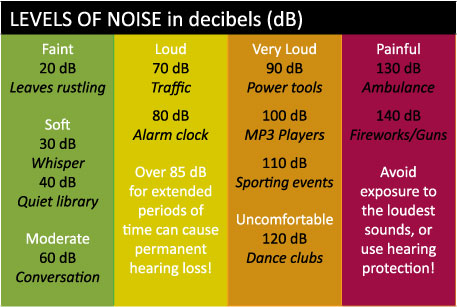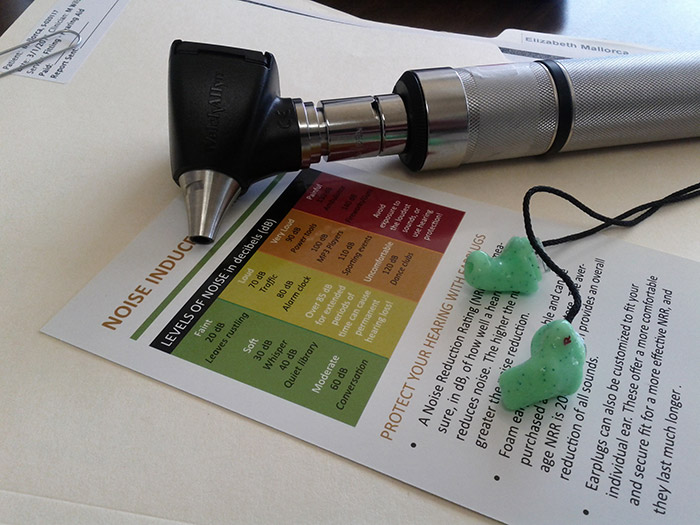Hearing Loss Prevention
Noise Induced Hearing Loss
Approximately 36 million Americans have hearing loss. One in three developed their hearing loss because of exposure to noise and loud sounds. Noise-induced hearing loss is caused by damage to the delicate hair cells of your inner ear. Once the hair cells are destroyed by exposure to harmful sounds, they cannot grow back, resulting in permanent hearing loss. Check out the NIDCD for detailed information regarding the mechanisms of noise-induced hearing loss.
NIHL (Noise-Induced Hearing Loss) can be caused by a one-time exposure to loud sound as well as by repeated exposure to sounds at various loudness levels over an extended period of time.
Sound is measured in units called decibels. Decibel levels begin at zero, which is near total silence and the weakest sound our ears can hear. By comparison, a whisper is 30 decibels and a normal conversation is 60 decibels. An increase of 10 means that a sound is 10 times more intense, or powerful. To your ears, it sounds twice as loud. The sound of an ambulance siren at 120 decibels is about 1 trillion times more intense than the weakest sound our ears can hear. Sounds that reach 120 decibels are painful to our ears at close distances.
Scientists believe that, depending upon the type of sound, the pure force of its vibrations at high decibel levels can cause hearing loss. Recent studies also show that exposure to sounds at harmful decibel levels triggers the formation of molecules inside the ear that damage hair cells. These destructive molecules play an important role in hearing loss in children and adults who listen to loud noise for too long.
Harmful Sounds

Harmful sounds may be present at work, at home, or during leisure activities. Two types of sounds are primarily responsible for noise induced hearing loss: 1) very loud sounds that are sudden or impulsive (e.g., fireworks) and 2) moderately-loud sounds of longer duration (e.g., music over an extended period of time). A sound is dangerous if:
- It is painful or causes “ringing” in your ears.
- You have to should over the sound or noise in order to be heard.
- It causes a temporary decrease in hearing.
Can NIHL Be Prevented?
NIHL is 100 percent preventable. All individuals should understand the hazards of noise and how to practice good hearing health in everyday life. To protect your hearing:
- Know which noises can cause damage (those at or above 85 decibels).
- Wear earplugs or other hearing protective devices when involved in a loud activity (special earplugs and earmuffs are available at hardware and sporting goods stores).
- Be alert to hazardous noise in the environment.
- Protect the ears of children who are too young to protect their own.
- Make family, friends, and colleagues aware of the hazards of noise.
- If you suspect hearing loss, have a medical examination by an otolaryngologist (a physician who specializes in diseases of the ears, nose, throat, head, and neck) and a hearing test by an audiologist (a health professional trained to measure and help individuals deal with hearing loss.
Protecting Your Hearing with Earplugs

A Noise Reduction Rating (NRR) is the measure, in decibels (dB), of how well a hearing protector reduces noise. The higher the number, the greater the noise reduction. Foam earplugs are disposable and can be purchased at your local drugstore. The average NRR is 20-30 dB, which provides an overall reduction of all sounds. Earplugs can also be to fit your individual ears. These offer a more comfortable and secure fit for a more effective NRR, and they last much longer. Please visit Westone to learn more about custom fit earplugs.
Who Should Use Hearing Protection?
- Firefighters, paramedics, and police
- Construction and industrial workers
- Musicians and concert-goers
- Spectators at sporting events
- Recreational shooters
Protect Yourself Today
You only have one set of ears – protect them for life! The appointment time for custom-made ear plugs is approximately 30 minutes. The audiologist will look in your ear canal and make sure it is clear and safe to take custom impressions. You will pick out color and style options. It then takes about a week and a half for the ear plugs to be made. Call us for an appointment today!
Music and Noise-Induced Hearing Loss
Any sound at a level of 85 dB for an extended amount of time can be harmful to your hearing. This includes music, and personal MP3 players can emit sound as loud at 100 dB! Amplified concerts and dance clubs often exceed 100 dB and can reach 140 dB! A temporary threshold shift (TTS) is a decrease in your hearing after exposure to loud sounds. Damage has been done to the delicate cells of your inner ears – this is why you hear “ringing.” While TTS usually goes away, repeated and prolonged exposure to loud sounds will cause permanent hearing loss. The damage first occurs in the high frequency regions of hearing, causing you to miss the soft consonants of speech.
Tips for Safer Listening
For personal MP3 use:
- Keep the volume down.
- Limit the amount of time you spend listening to music.
- Take breaks! Give your ears a chance to rest between listening sessions.
- Use noise-cancelling headphones or noise-isolation ear buds to block noise – so that you don’t turn the volume up even more.
For attending a concert:
- Use disposable or custom made earplugs!
- Foam earplugs reduce dangerous sound levels but do not preserve the quality of music.
- Musicians earplugs are custom-made to fit your individual ears. They contain special filters that preserve the fidelity of music so that sound quality is clear and natural, not muffled.
Who Use Musicians’ Earplugs?
- Instrumentalists and vocalists
- Concert and club-goers
- Sound mixers and editors
- Music teachers and students
- Bartenders and waitstaff
- Sports enthusiasts
Noise-Induced Hearing Loss and Children
Here are some startling statistics: 2.5% of 6-19 year olds in the U.S. (5.2 million kids) have elevated hearing thresholds directly attributed to noise exposure (WHO) and 1 in 5 teenagers now have documented hearing loss, a huge increase in recent years (American Medical Association). We often overlook the dangers of noise and music in school-aged children and teenagers. Help your kids understand how hearing works and how it can be easily damaged by loud noise. Check out these great online, interactive resources:
Protecting Your Baby’s Hearing
Hearing loss prevention has long been something adults have been conscious of, and in recent times, earmuffs for kids have become a huge industry. But amidst all this, one group has been largely ignored – babies. Like older people, a baby’s hearing is sensitive to loud noises and needs protection.
While the simplest solution would be to keep babies away from noisy events, this is easier said than done. A lot of families enjoy spending time together, no matter what the environment. In addition, it is not always possible (or comfortable) to use a babysitter for an infant. For this reason, it is essential to have items on hand that protect a baby’s hearing.
If you, or someone you know, often take their baby to noisy environments, you’ll appreciate just how important it is to have baby hearing protection available. To find a complete range of hearing protection options for babies, head to: www.earmuffsforkids.com
Drugs and Hearing Loss
Approximately 200 prescription and over-the counter drugs are ototoxic, meaning that they can cause permanent or temporary damage to your auditory and/or vestibular (balance) system. Ototoxic drugs can cause sensorineural hearing loss, which occurs when there is damage to the inner ear (cochlea) or to the nerve pathways from the inner ear (retrocochlear) to the brain. Hearing loss caused by ototoxic medications first affects the high pitches above 9,000 Hz.
Medical Conditions and Drug Use
Several medical conditions can also negatively impact your hearing. And when you combine these conditions with ototoxic drugs, the risk of hearing loss is greater.
- Diabetes Mellitus
- Arteriosclerosis
- Low Thyroid
- Poor Kidney function
Common Ototoxic Drugs*
- Aminoglycoside
- Antibiotics
- Anesthetics
- Antiarrhythmics
- Antidepressants
- Antimalarials
- Anti-inflammatory drugs
- Beta blockers
- Chemotherpy drugs (e.g., Cisplatin)
- Glucocorticosteroids
- Loop Diuretics
- Various solvents and vapors
- Some heavy metals
*It is important to remember that you should never discontinue any drug without first consulting your doctor!
Recommendations
- Always inform your physician of hearing loss or balance disorders.
- Ask your physician if any of your prescribed medications are ototoxic.
- Read drug labels and talk to your pharmacist about ototoxic side effects.
- Monitor your hearing before, during, and after any ototoxic drug use.
- If you notice a sudden change in hearing or balance, consult your physician immediately.
